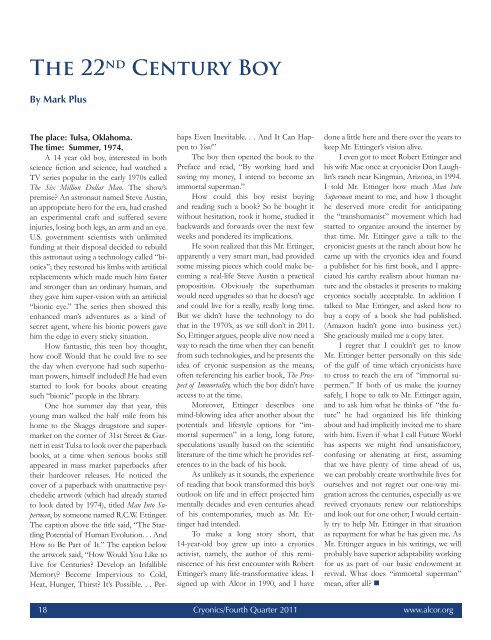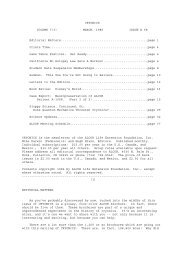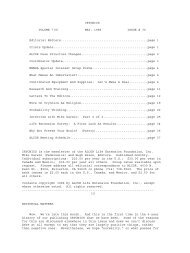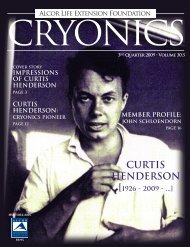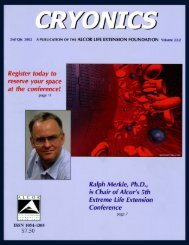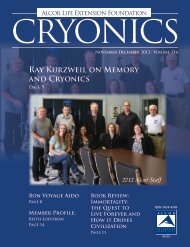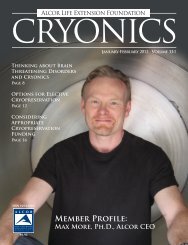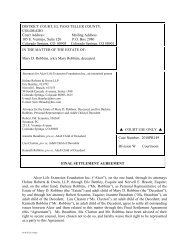Robert Ettinger - Alcor Life Extension Foundation
Robert Ettinger - Alcor Life Extension Foundation
Robert Ettinger - Alcor Life Extension Foundation
Create successful ePaper yourself
Turn your PDF publications into a flip-book with our unique Google optimized e-Paper software.
The 22 nd Century Boy<br />
By Mark Plus<br />
The place: Tulsa, Oklahoma.<br />
The time: Summer, 1974.<br />
A 14 year old boy, interested in both<br />
science fiction and science, had watched a<br />
TV series popular in the early 1970s called<br />
The Six Million Dollar Man. The show’s<br />
premise? An astronaut named Steve Austin,<br />
an appropriate hero for the era, had crashed<br />
an experimental craft and suffered severe<br />
injuries, losing both legs, an arm and an eye.<br />
U.S. government scientists with unlimited<br />
funding at their disposal decided to rebuild<br />
this astronaut using a technology called “bionics”;<br />
they restored his limbs with artificial<br />
replacements which made much him faster<br />
and stronger than an ordinary human, and<br />
they gave him super-vision with an artificial<br />
“bionic eye.” The series then showed this<br />
enhanced man’s adventures as a kind of<br />
secret agent, where his bionic powers gave<br />
him the edge in every sticky situation.<br />
How fantastic, this teen boy thought,<br />
how cool! Would that he could live to see<br />
the day when everyone had such superhuman<br />
powers, himself included! He had even<br />
started to look for books about creating<br />
such “bionic” people in the library.<br />
One hot summer day that year, this<br />
young man walked the half mile from his<br />
home to the Skaggs drugstore and supermarket<br />
on the corner of 31st Street & Garnett<br />
in east Tulsa to look over the paperback<br />
books, at a time when serious books still<br />
appeared in mass market paperbacks after<br />
their hardcover releases. He noticed the<br />
cover of a paperback with unattractive psychedelic<br />
artwork (which had already started<br />
to look dated by 1974), titled Man Into Superman,<br />
by someone named R.C.W. <strong>Ettinger</strong>.<br />
The caption above the title said, “The Startling<br />
Potential of Human Evolution. . . And<br />
How to Be Part of It.” The caption below<br />
the artwork said, “How Would You Like to<br />
Live for Centuries? Develop an Infallible<br />
Memory? Become Impervious to Cold,<br />
Heat, Hunger, Thirst? It’s Possible. . . Per-<br />
haps Even Inevitable. . . And It Can Happen<br />
to You!”<br />
The boy then opened the book to the<br />
Preface and read, “By working hard and<br />
saving my money, I intend to become an<br />
immortal superman.”<br />
How could this boy resist buying<br />
and reading such a book? So he bought it<br />
without hesitation, took it home, studied it<br />
backwards and forwards over the next few<br />
weeks and pondered its implications.<br />
He soon realized that this Mr. <strong>Ettinger</strong>,<br />
apparently a very smart man, had provided<br />
some missing pieces which could make becoming<br />
a real-life Steve Austin a practical<br />
proposition. Obviously the superhuman<br />
would need upgrades so that he doesn’t age<br />
and could live for a really, really long time.<br />
But we didn’t have the technology to do<br />
that in the 1970’s, as we still don’t in 2011.<br />
So, <strong>Ettinger</strong> argues, people alive now need a<br />
way to reach the time when they can benefit<br />
from such technologies, and he presents the<br />
idea of cryonic suspension as the means,<br />
often referencing his earlier book, The Prospect<br />
of Immortality, which the boy didn’t have<br />
access to at the time.<br />
Moreover, <strong>Ettinger</strong> describes one<br />
mind-blowing idea after another about the<br />
potentials and lifestyle options for “immortal<br />
supermen” in a long, long future,<br />
speculations usually based on the scientific<br />
literature of the time which he provides references<br />
to in the back of his book.<br />
As unlikely as it sounds, the experience<br />
of reading that book transformed this boy’s<br />
outlook on life and in effect projected him<br />
mentally decades and even centuries ahead<br />
of his contemporaries, much as Mr. <strong>Ettinger</strong><br />
had intended.<br />
To make a long story short, that<br />
14-year-old boy grew up into a cryonics<br />
activist, namely, the author of this reminiscence<br />
of his first encounter with <strong>Robert</strong><br />
<strong>Ettinger</strong>’s many life-transformative ideas. I<br />
signed up with <strong>Alcor</strong> in 1990, and I have<br />
done a little here and there over the years to<br />
keep Mr. <strong>Ettinger</strong>’s vision alive.<br />
I even got to meet <strong>Robert</strong> <strong>Ettinger</strong> and<br />
his wife Mae once at cryonicist Don Laughlin’s<br />
ranch near Kingman, Arizona, in 1994.<br />
I told Mr. <strong>Ettinger</strong> how much Man Into<br />
Superman meant to me, and how I thought<br />
he deserved more credit for anticipating<br />
the “transhumanist” movement which had<br />
started to organize around the internet by<br />
that time. Mr. <strong>Ettinger</strong> gave a talk to the<br />
cryonicist guests at the ranch about how he<br />
came up with the cryonics idea and found<br />
a publisher for his first book, and I appreciated<br />
his earthy realism about human nature<br />
and the obstacles it presents to making<br />
cryonics socially acceptable. In addition I<br />
talked to Mae <strong>Ettinger</strong>, and asked how to<br />
buy a copy of a book she had published.<br />
(Amazon hadn’t gone into business yet.)<br />
She graciously mailed me a copy later.<br />
I regret that I couldn’t get to know<br />
Mr. <strong>Ettinger</strong> better personally on this side<br />
of the gulf of time which cryonicists have<br />
to cross to reach the era of “immortal supermen.”<br />
If both of us make the journey<br />
safely, I hope to talk to Mr. <strong>Ettinger</strong> again,<br />
and to ask him what he thinks of “the future”<br />
he had organized his life thinking<br />
about and had implicitly invited me to share<br />
with him. Even if what I call Future World<br />
has aspects we might find unsatisfactory,<br />
confusing or alienating at first, assuming<br />
that we have plenty of time ahead of us,<br />
we can probably create worthwhile lives for<br />
ourselves and not regret our one-way migration<br />
across the centuries, especially as we<br />
revived cryonauts renew our relationships<br />
and look out for one other; I would certainly<br />
try to help Mr. <strong>Ettinger</strong> in that situation<br />
as repayment for what he has given me. As<br />
Mr. <strong>Ettinger</strong> argues in his writings, we will<br />
probably have superior adaptability working<br />
for us as part of our basic endowment at<br />
revival. What does “immortal superman”<br />
mean, after all? �<br />
18 Cryonics/Fourth Quarter 2011 www.alcor.org


